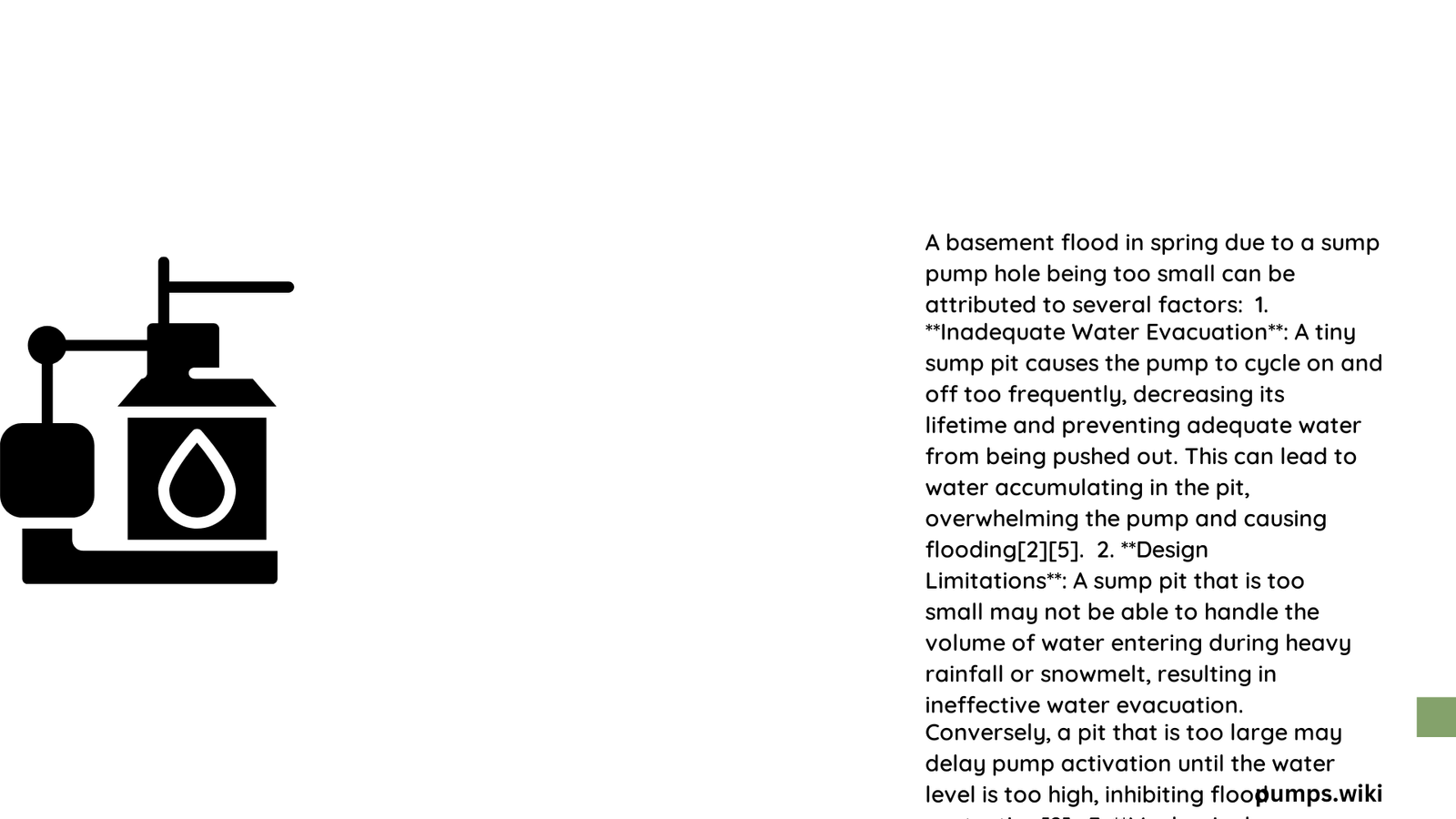Spring basement floods can devastate homeowners, especially when a small sump pump hole becomes overwhelmed by rising groundwater. Inadequate sump pit dimensions compromise water removal efficiency, creating potential for significant structural damage, mold growth, and costly repairs. Understanding the critical relationship between sump pump hole size and water management is essential for preventing catastrophic flooding scenarios.
What Causes Basement Floods During Spring?
Spring brings increased groundwater levels due to snowmelt and heavy rainfall, which can quickly overwhelm undersized sump pump systems. The primary culprits include:
- Insufficient pit diameter
- Limited water removal capacity
- Improper pump sizing
- Poor drainage infrastructure
How Large Should a Sump Pump Hole Be?
| Pit Dimension | Water Capacity | Recommended Use |
|---|---|---|
| 18″ diameter | 1 gallon/inch | Small basements |
| 24″ diameter | 2 gallons/inch | Medium homes |
| 30″ diameter | 3 gallons/inch | Large structures |
Critical Measurements for Effective Water Management
Experts recommend specific sump pump hole dimensions to ensure optimal performance:
- Diameter Range: 18-24 inches
- Recommended Depth: Minimum 30 inches
- Water Accumulation Capacity: At least 1-2 gallons per inch
What Risks Emerge from Small Sump Pump Holes?
When sump pump holes are too small, homeowners face multiple potential risks:
- Rapid Water Accumulation: Insufficient drainage leads to quick basement flooding
- Pump Overload: Constant cycling reduces equipment lifespan
- Structural Damage: Prolonged water exposure compromises foundation integrity
- Mold and Mildew: Persistent moisture creates health hazards
How Can Homeowners Resolve Small Sump Pump Hole Issues?

Addressing inadequate sump pump infrastructure requires strategic interventions:
- Professional Assessment
- Measure current pit dimensions
- Evaluate water table levels
-
Determine optimal pump capacity
-
Pit Expansion Techniques
- Enlarge existing pit
- Install deeper sump basin
-
Consider professional concrete cutting
-
Pump Upgrade Strategies
- Select higher horsepower models
- Choose submersible pumps
- Install backup systems
What Professional Solutions Exist?
Certified waterproofing experts can provide comprehensive solutions:
- Comprehensive site evaluation
- Custom sump pit design
- Advanced drainage system installation
- Moisture barrier implementations
Technical Considerations for Sump Pump Performance
Water Removal Calculations:
– 10 square feet of basement = 1 gallon/minute removal
– Sandy soil: 14 gallons/minute per 1,000 sq. ft.
– Clay soil: 8 gallons/minute per 1,000 sq. ft.
Preventative Maintenance Recommendations
- Annual professional inspection
- Regular pit cleaning
- Check pump functionality
- Monitor water levels during spring
Cost-Benefit Analysis
| Solution | Average Cost | Potential Savings |
|---|---|---|
| Pit Enlargement | $500-$1,500 | $10,000+ in damage prevention |
| Pump Upgrade | $300-$800 | Continuous protection |
| Comprehensive System | $2,000-$5,000 | Entire home water management |
Pro Tip: Invest in prevention to avoid exponentially higher repair costs.
Final Thoughts on Spring Basement Flood Prevention
Understanding and addressing sump pump hole limitations is crucial for protecting your home. Proactive measures, professional assessments, and strategic upgrades can significantly mitigate spring flooding risks.
References:
– Hays Cooling and Heating Sump Pump Guide
– RadonSeal Sump Pit Sizing
– Zoeller Pump Company Recommendations
